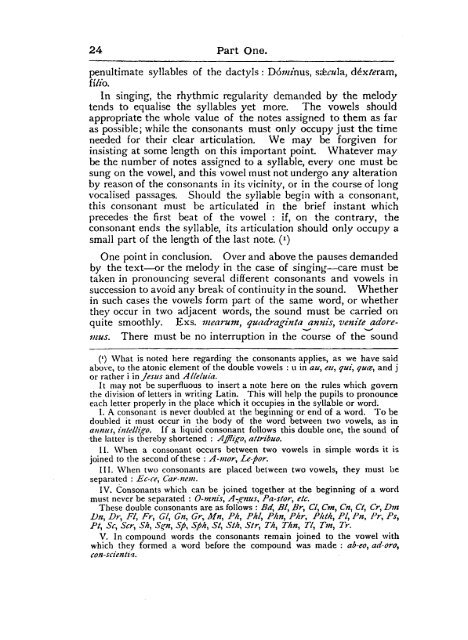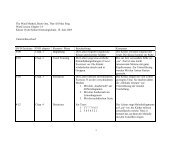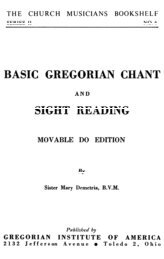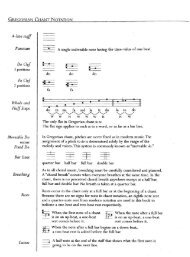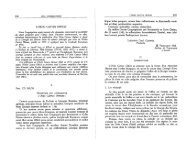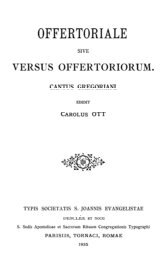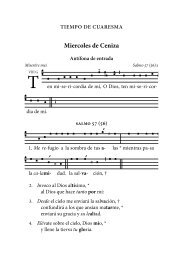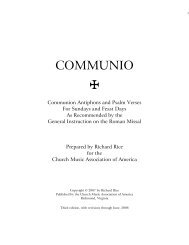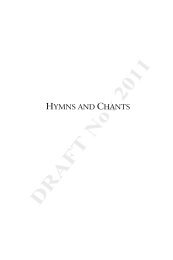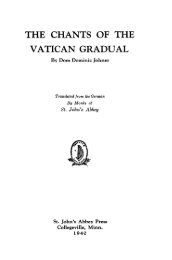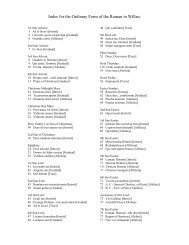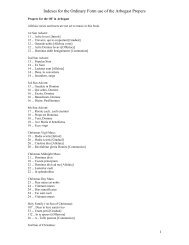Textbook of Gregorian Chant (1930) - MusicaSacra
Textbook of Gregorian Chant (1930) - MusicaSacra
Textbook of Gregorian Chant (1930) - MusicaSacra
Create successful ePaper yourself
Turn your PDF publications into a flip-book with our unique Google optimized e-Paper software.
24 Part One.<br />
penultimate syllables <strong>of</strong> the dactyls: D6///mus, saerwla, ctexteram,<br />
ff/ib.<br />
In singing, the rhythmic regularity demanded by the melody<br />
tends to equalise the syllables yet more. The vowels should<br />
appropriate the whole value <strong>of</strong> the notes assigned to them as far<br />
as possible; while the consonants must only occupy just the time<br />
needed for their clear articulation. We may be forgiven for<br />
insisting at some length on this important point. Whatever may<br />
be the number <strong>of</strong> notes assigned to a syllable, every one must be<br />
sung on the vowel, and this vowel must not undergo any alteration<br />
by reason <strong>of</strong> the consonants in its vicinity, or in the course <strong>of</strong> long<br />
vocalised passages. Should the syllable begin with a consonant,<br />
this consonant must be articulated in the brief instant which<br />
precedes the first beat <strong>of</strong> the vowel : if, on the contrary, the<br />
consonant ends the syllable, its articulation should only occupy a<br />
small part <strong>of</strong> the length <strong>of</strong> the last note. (*)<br />
One point in conclusion. Over and above the pauses demanded<br />
by the text—or the melody in the case <strong>of</strong> singing—care must be<br />
taken in pronouncing several different consonants and vowels in<br />
succession to avoid any break <strong>of</strong> continuity in the sound. Whether<br />
in such cases the vowels form part <strong>of</strong> the same word, or whether<br />
they occur in two adjacent words, the sound must be carried on<br />
quite smoothly. Exs. mearum, quadraginta annis, venite adoremus.<br />
There must be no interruption in the course <strong>of</strong> the sound<br />
(') What is noted here regarding the consonants applies, as we have said<br />
above, to the atonic element <strong>of</strong> the double vowels : u in au, en, qui, qua, and j<br />
or rather i in Jesus and Alleluia.<br />
It may not be superfluous to insert a note here on the rules which govern<br />
the division <strong>of</strong> letters in writing Latin. This will help the pupils to pronounce<br />
each letter properly in the place which it occupies in the syllable or word.<br />
I. A consonant is never doubled at the beginning or end <strong>of</strong> a word. To be<br />
doubled it must occur in the body <strong>of</strong> the word between two vowels, as in<br />
annus, iiitelligo. If a liquid consonant follows this double one, the sound <strong>of</strong><br />
the latter is thereby shortened : Affligo, attribuo.<br />
II. When a consonant occurs between two vowels in simple words it is<br />
joined to the second <strong>of</strong> these : A-mor, Le f fior.<br />
III. When two consonants are placed between two vowels, they must be<br />
separated : Ec-ce, Car-nem.<br />
IV. Consonants which can be joined together at the beginning <strong>of</strong> a word<br />
must never be separated : O-mnzsy A-gnus, Pas/or, etc.<br />
These double consonants are as follows : Bd, Bl% Br, Cl, Cm, Cn, Ct, Cr, Dm<br />
Dn, Dr, Fl, Fr, Gl, Gn, Gr, Mn, Ph, Phi, Phn, Phr, Phth, PI, Pn, Pr, Ps,<br />
Pt, Sc, Scr, Sh, S?n, Sp, Sph, St, Sth, Str, Th, Thn, Tl, Tmy Tr.<br />
V. In compound words the consonants remain joined to the vowel with<br />
which they formed a word before the compound was made : ab~eo, adoro^<br />
con-scientia.


